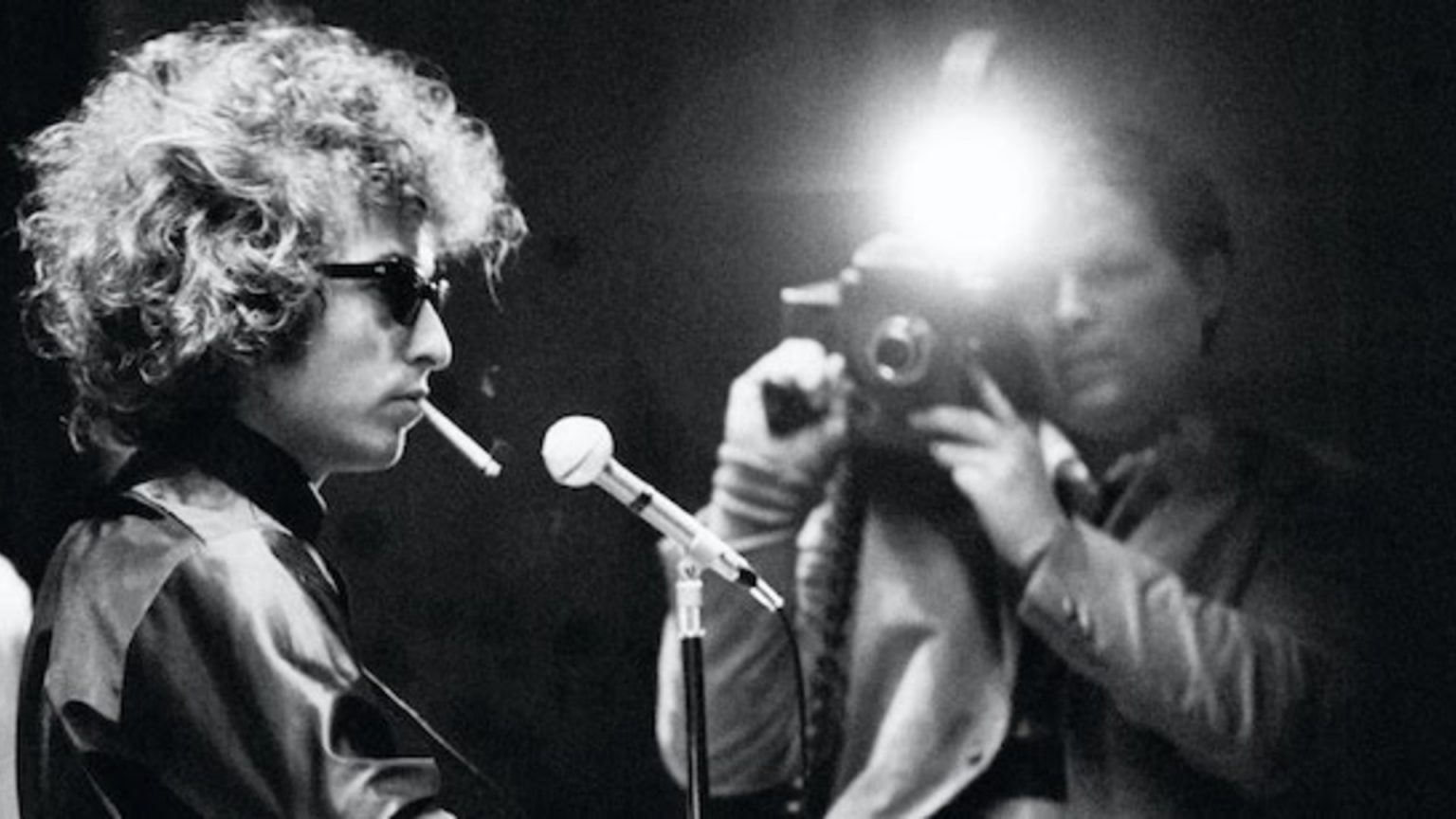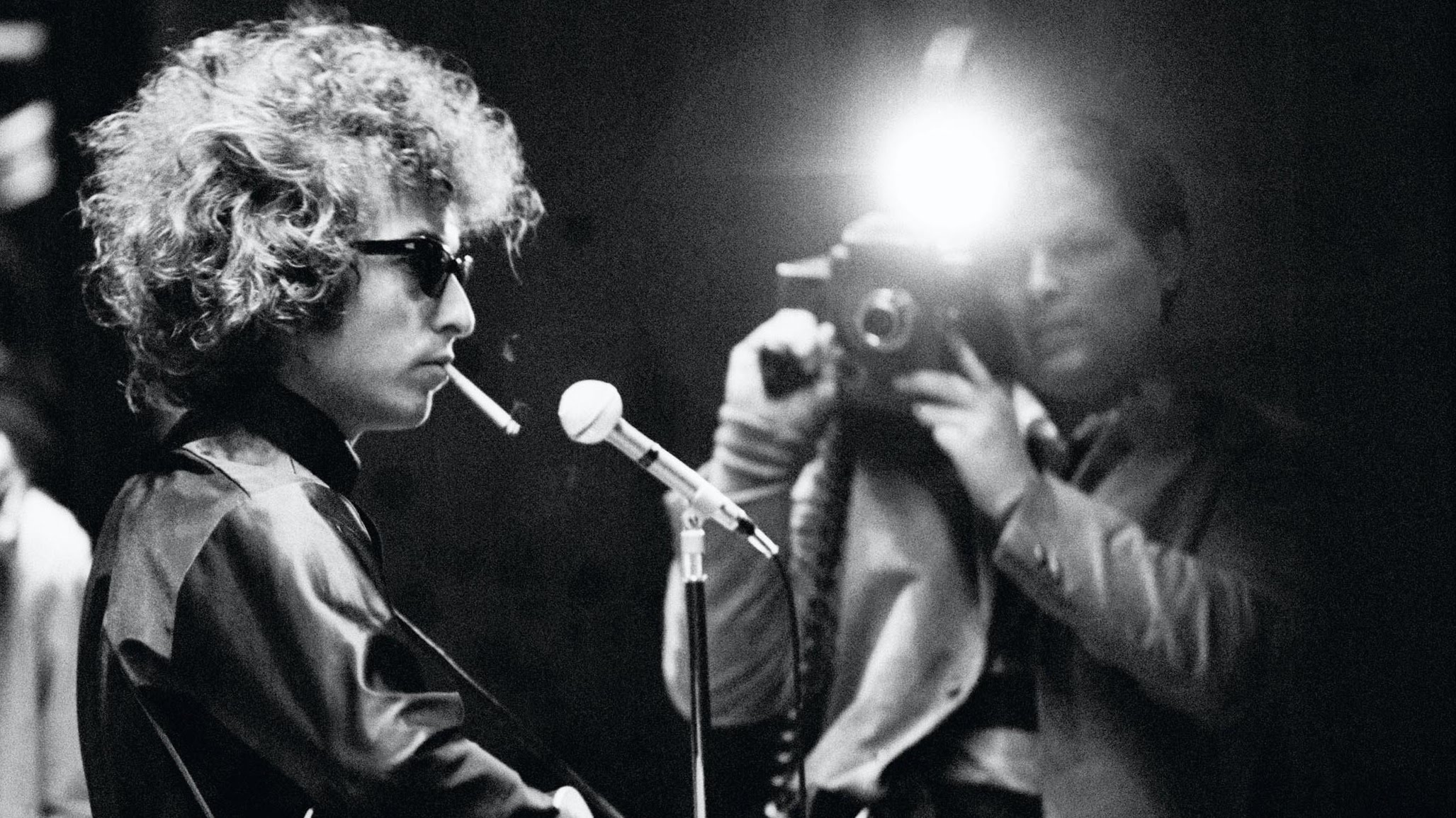
In the midst of a 2007 tribute presented by the Documentary Film Institute, Jonathan Marlow had the opportunity to speak with D.A. Pennebaker about his remarkable fifty-year career. Best known for his music films, such as Monterey Pop and Down from the Mountain, Pennebaker is also responsible for a number of exceptional political documentaries: The War Room, as director, Al Franken: God Spoke, as producer, and One PM, a documentary/narrative hybrid which was started and abandoned by Jean-Luc Godard.
[Editor’s note: This interview was originally published by Greencine, in two parts, in March of 2007. At the time, a DVD of the landmark documentary Dont Look Back was being reissued. Today, D.A. Pennebaker turns ninety and we celebrate by revisiting a pair of Pennebaker interviews. Stay tuned for Fandor’s Friday release of Pennebaker colleague Richard Leacock and Valérie Lalonde‘s Les oeufs à la coque.]
Jonathan Marlow: Your first film, Daybreak Express, is arguably one of the most stunning short films ever made.
D.A. Pennebaker: I have to freely admit that it owes a little something to [Duke] Ellington!
Marlow: At what point did you decide to use Ellington as the springboard…
Pennebaker: I began by wanting to use that song and that’s why the film has no title. It’s known as Daybreak Express but that’s the title of the song. I didn’t want to co-op the song to my little film. I had to show it to Ellington because, at the time, I didn’t know anything about making a film. I didn’t make a print or anything. I took the original stuff, which was Kodachrome…
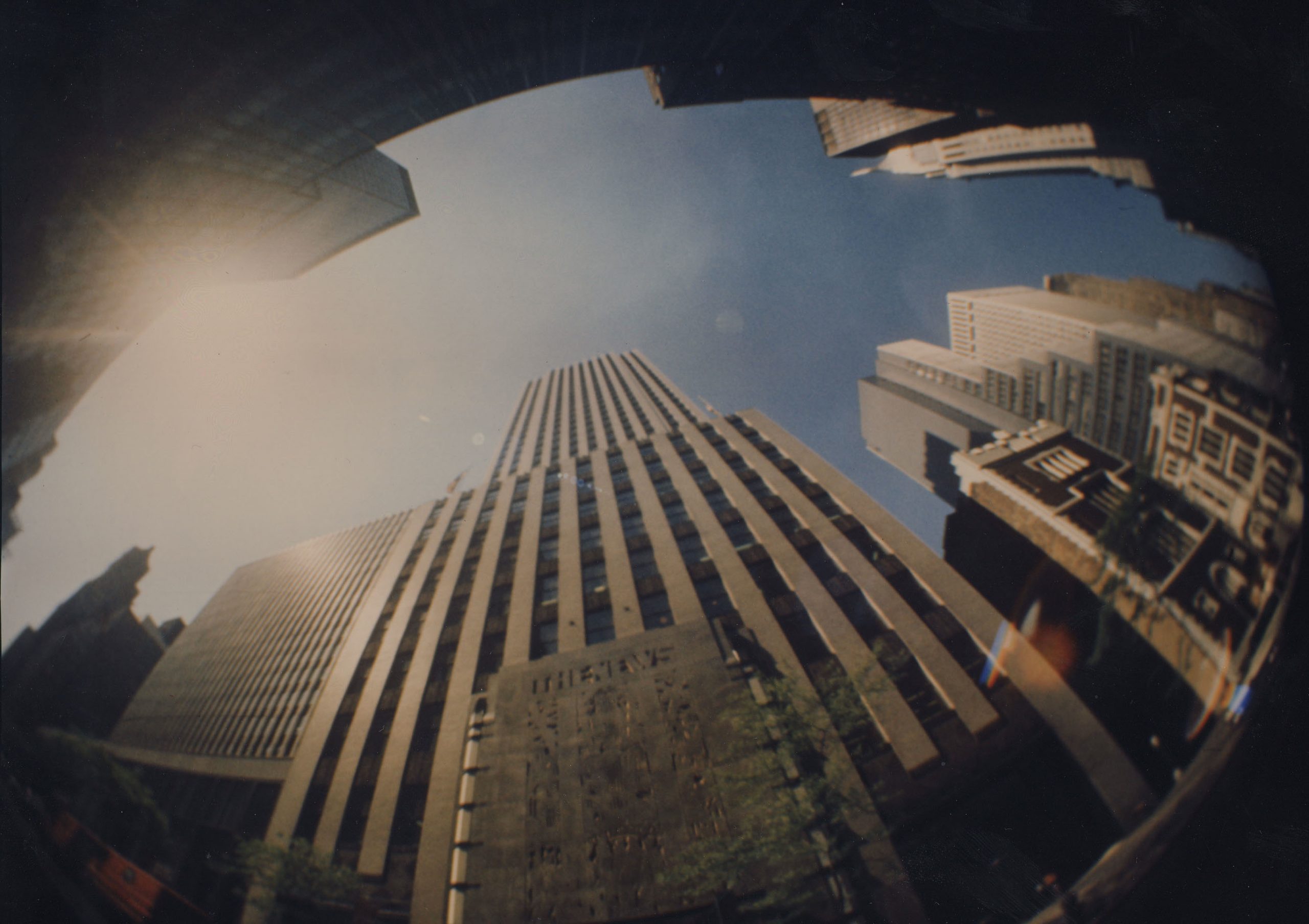
Marlow: Was it reversal or negative?
Pennebaker: Reversal. You bought it for ten dollars a roll at the drugstore. You sent it to them and they processed it and sent it back. The short took about three or four rolls. Since a roll is about three-and-a-half minutes long and the record was about three-and-a-half long, in the beginning I thought that, if I’m really smart and can start and stop that camera accurately, I could do it all on one roll. Of course, you could never do that! When the rolls came back, I didn’t even know how to fasten the film together. I knew that I had to do it somehow so I did it with adhesive tape. It looked terrible. Actually, I liked the effect of the sudden ‘slug’ at the cut.
A few years later, I made a film called Company. I had a guy working for me as a kind of apprentice. His father was a sculptor and I thought quite highly of him. I had to go away somewhere and I left him with the problem of cutting the original film into what is called ‘A’ and ‘B’ rolls. By having them run, first one and the other, on your print, you manage to cover up the splice. He got confused and made the splices so that, instead of covering them, they doubled. He thought that it was a disaster. When I looked at it, I thought that there wasn’t anything we could do. We couldn’t change the music. There wasn’t any way to extend or change the shots. We were stuck with it. I showed it over the course of the next week or two. Nobody noticed except the producer and he said, ‘Why do you have those funny blips between each cut?’ I said, ‘Because I think it kind of ups the excitement.’ And he said, ‘Great idea!’ The Canadians later wanted to know if I had some kind of ‘splice master’ that I used. I’ve lived with it ever since! Most people don’t notice but it’s like a little time clock going off in the back of their head. It makes it look more exciting but you would never want to do it. I would never do it again.

Daybreak had that quality. I had to show it to Ellington in his office on a little projector with a tape recorder to run the sound. By present standards, it would have been unbearable but it looked great. He loved it.
Marlow: Was it this experience that made you decide to pursue a career as a filmmaker?
Pennebaker: I actually decide before that. Not long before. I had built a setup in my New York apartment with a projector in a wooden booth and, underneath, I had a turntable. I could show films and play music [for accompaniment]. On a Sunday afternoon, if it were raining, we would get old movies and play Jelly Roll Morton. Francis Thompson came to show a film he had been working on for a long time called New York, New York – [N.Y., N.Y.]…
I was an engineer, actually. I have an engineering degree from Yale. I assumed that I’d be an engineer for some time. After about a year of it, I realized I didn’t want to do that anymore. I had a writer friend who said, ‘You’ve got to quit. You can’t do that.’ At the time, I thought I would become a writer. We were sharing an apartment and I wondered how I would pay the rent. He said, ‘Don’t worry about it because what you’ll learn is how to live in New York without a job.’ And, indeed, I did. I’ve never had a job since. But the whole idea of being a writer… I started a novel and I got about a third of the way through but it was clear to me, upon sober reflection, that it was going to be just another book. I wasn’t F. Scott Fitzgerald.
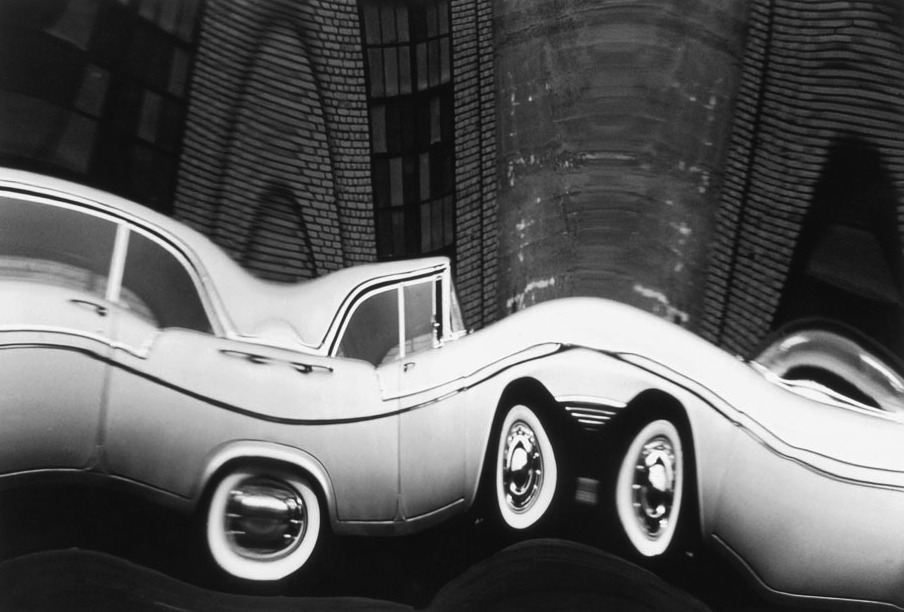
Marlow: It wasn’t the great American novel.
Pennebaker: There was no way I was going to write This Side of Paradise. Anything short of that would have been a disappointment so I thought I’d better think this writing thing through. When Francis showed me the work print [of N.Y., N.Y.], he also had a record playing with it—[Bela] Bartok. I had never heard Bartok before although I knew quite a bit about music. I’d spent time in music school during my senior year at Yale. The combination [of image and sound] was terrific. The picture was very artistic. It was all abstractions, quite beautiful, but that wasn’t what interested me. What interested me was that he’d made this film all by himself. I had no idea how movies were made before that. I’d never thought about it much. As a result, in about fifteen minutes I saw right away that filmmaking was what I was going to do for the rest of my life. Little by little, I weaseled my way into the world of independent filmmaking in New York. It was a very haphazard thing at that time but there were a number of people who were making films for a very small audience. There was no television to speak of. I guess that I was very naïve. I assumed, having the benefit of several years of college as a result of the G.I. Bill, that everything would sort of work out. You develop that theory even though, if you look around America, that’s not realistically the case.
Marlow: You owe your career to naivete.
Pennebaker: I owe my career to being a slow learner. Entirely.
Marlow: How did you meet Robert Drew?
Pennebaker: After a few years of doing some films, I went to Russia for three months to make a film that was set up there by George Nelson involving Nixon and Khrushchev. I’d actually shot Daybreak but I hadn’t released it. I didn’t know what to do with it. Willard Van Dyke, who Ricky [Richard Leacock] worked with sometimes, came to me. I guess that he had seen a screening of Daybreak. He had to do a series for the Brussels World’s Fair [Expo ’58] of loop films and he talked to me about doing a few. I said that I’d be happy to do it. There was not much money and it involved about a year of traveling around the U.S. to shoot them, but it sounded exactly like what I should be doing. In the course of that I got to meet Ricky since he made one of them [known as Brussels Loops; Shirley Clarke and Wheaton Galentine also participated] and he was doing this project with Drew. While I was in Russia, he came over with Lenny Bernstein and they shot a concert of the New York Philharmonic and the Russian Philharmonic there. He brought with him a very haphazardly constructed sync-sound thing. That was a big problem. You could shoot films with a tape recorder, the same type of wind-up tape recorder on which I had run the track for Ellington to show him Daybreak, but there was no way to go out in the field with the camera and shoot the sound of people with dialogue. It was impossible. You had to do it on a set, plugged into the wall. You had to go through the whole process. While we were there, he had this thing and it took three of us—Al Maysles was with me—to carry it. Long wires and a battery about the size of a Volkswagen, we would be following Lenny down halls…
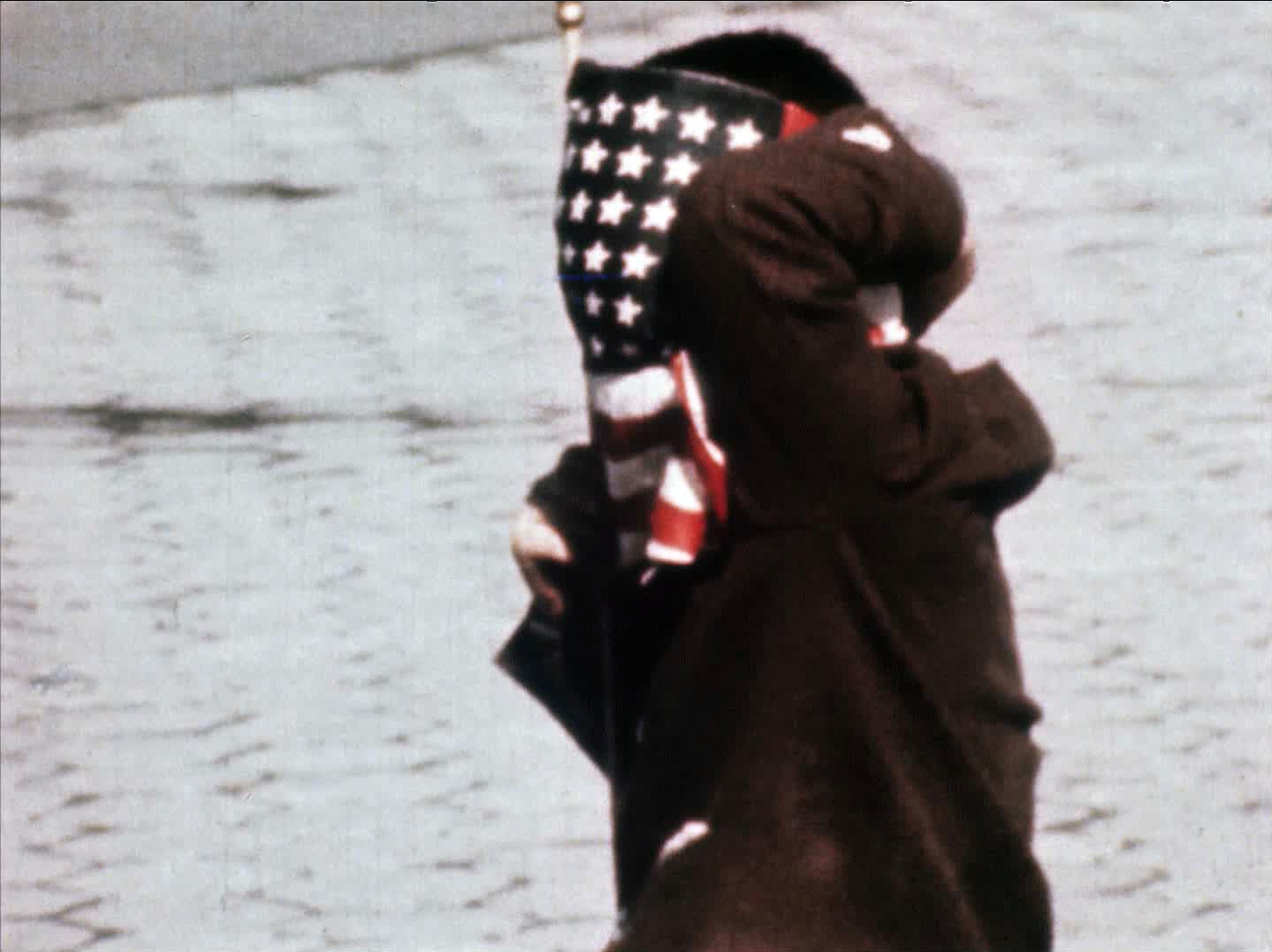
Marlow: Did you do this with a cart behind you? How did you carry all this stuff?
Pennebaker: We had a microphone that was maybe this long. A directional mic…
Marlow: On a boom?
Pennebaker: Not on a boom. The tape recorder made quite a bit of noise, a terribly noisy thing, and the camera shot only a hundred feet of film. That was all it shot and then you had to reload. We had to be following Lenny who would be complaining bitterly that we were messing up his life with this stupid contraption. It didn’t look like it had much future. We set it down in this hall where Lenny was going to entertain some party officials and, in the course of it, I remember that he sat down and started to play current American music because that’s what they wanted to hear. He wasn’t going to play anything very complicated for them. It isn’t my favorite music but I do know when it’s good. Lenny was a fantastic piano player and I thought, ‘I’ve got this machine here that should be able to sync.’ I shot two rolls of film and that made me think, ‘That’s what we have to do! We’ve got to figure out how to get this thing to work because it’s always the thing that you don’t expect that you want to film.’ When we got back to New York, Drew had asked Ricky to do this balloon assent out in South Dakota or North Dakota. They had shot once before and the balloon hadn’t gone up due to weather conditions or something. Ricky couldn’t go so Drew asked me to do it. By then, Ricky and I had sort of formed a partnership with Shirley Clarke and Willard Van Dyke. The four of us shared a little office in New York. I went out and spent a couple of months trying to film this balloon taking off. Drew meanwhile had persuaded Time Life to put up money for a program involving filmmakers like ourselves doing a kind of projected series, a kind of candid series like they had done for still photograph. Drew, who had come done down from the Neiman Fellowship [at Harvard], had seen Ricky’s film called Toby and the Tall Corn, and he’d fallen in love with it. I had seen it and I’d also fallen in love. Daybreak Express was my attempt to become a cinematographer overnight. It was also my expression of affection for John Sloan, who loved elevators and did these fantastic pictures of New York, which I’ve always adored. He is the New York painter of all time. That was my little offering to him. I didn’t want to make little contrived funny movies and so I never really tried to make Daybreak again or anything like it.
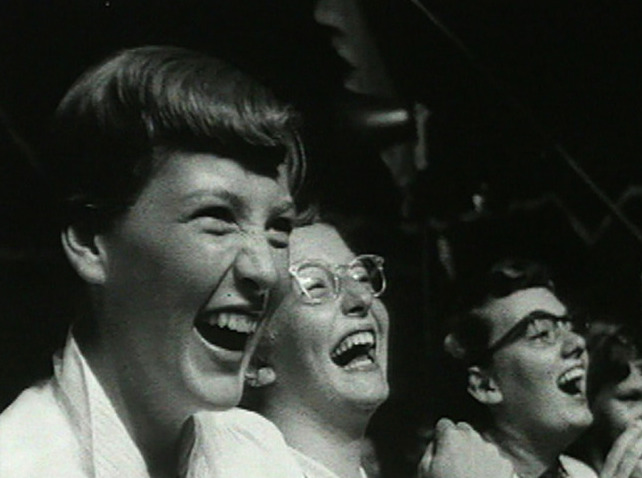
By now, we set out with Time Life to really design a camera that would be quite portable and work anywhere. We had [Stefan] Kudelski who developed the Nagra, and we got to know him pretty well. We started out by putting Bulova watches—Accutron watches—on the Nagra and then one on the camera, so if the two were keeping the same time…
Marlow: …then they were in sync.
Pennebaker: They could be made to drive the two things. In the case of the tape recorder, it could simply lay down a signal in the middle of the tape. In the camera, it drove a rather complicated thing that was very inefficient but, little by little, over the next couple of years we managed to get a more efficient system of driving the DC feedback system. We stopped using the clocks because we could get crystals that were just as accurate. In the end, we designed and built about five cameras that were hand-made from existing Oracon cameras but they had very little Oracon stuff in them anymore. We chopped off the tops and raked the magazines so they sat back on your shoulder. You could hold the camera with a handle, kind of like what you get in a video cameras now. We were the only ones that had equipment like this. We made maybe a dozen films as part of this Time Life deal but, little by little, I could see that the problem was Time Life wasn’t going to get them into any kind of real distribution. That is, they were limited on TV when the ads were thrown in. They were much too short—you couldn’t develop character in forty-five minutes. You needed that ninety minute span that the movies have trained everybody to expect. I quit Time Life and Ricky joined me. In the beginning, we had a couple of projects but they didn’t turn out to be big money makers.
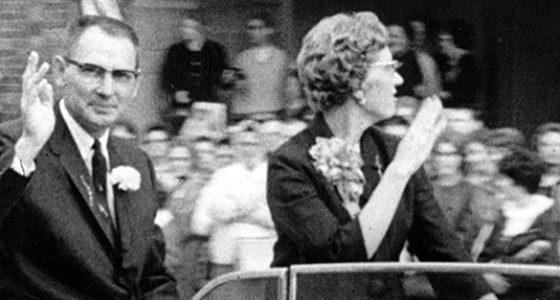
After Happy Mother’s Day was finished, the Saturday Post decided that they didn’t like it. They wanted to change it so we had to buy it back from them. I did a film with a Prime Minister in Canada. Another person later edited it and together we saw that it was not satisfactory. I determined that I wasn’t going to shoot films that someone else edited because it didn’t make use of what we thought we were doing. By then we were renting the cameras out and that irritated the Film Board a lot because we had to pay duty every time we came into Canada but they had no other camera that was quiet and did what this camera was able to do. We sort of survived for a year or two doing a lot of little short films. One with Dave Lambert [Lambert, Hendricks & Co.] and another with Timothy Leary, films that were maybe fifteen minutes long and which we could shoot in one day. We didn’t know what else to do. We had no market for them. Certainly television was never going to be a market for us. I could see that fairly quickly. I couldn’t even get people to look at Happy Mother’s Day.
Marlow: How much of your association with Drew, Leacock and the Maysles was simply a matter of time and place? Primary is certainly of that particular moment and later, as you mentioned, Albert Grossman offering you Don’t Look Back?
Pennebaker: In the beginning, Drew could go to the Kennedys by way of the Time Life reporter in Washington. He could get to Kennedy and asked if we could be with him. We got a kind of an uncertain ‘go ahead’ on that, so we were able to shoot Primary. For the next film, we had a kind of idea of what we were going to film but we had no story. We never tried to script it but it turned out to be really interesting when we got out and did it. Then we did a series that got us further into the refining of the process. ‘Did you have to process everything you shot?’ Decisions like that, which the Film Board had long ago gone through. We had to replicate their experience. I worked with Drew for three years. The last film we did was Crisis. It was an extraordinary film. We’ll never do another film like that again.
Marlow: Certainly, no one would give you that kind of access again.
Pennebaker: The most interesting thing for me was Jane Fonda. I could see that if you understood what the limitations were in the process, and didn’t try to make it via a Hollywood movie, you could make a real drama that you could also distribute theatrically. The stuff was there to do it if you did it right. That convinced me that is the way we had to go. The fact that we had Jane Fonda was interesting because you had a real actress, so you saw her. But she was over-acting. It wasn’t necessarily a film that was like Hollywood films. It just was like something that you knew had a real nest to go to. After I’d left Drew, within a couple of years Albert came and asked, ‘Would you want to go with [Bob] Dylan?’ I didn’t know that it was going to be a feature film but that was the way I intended to shoot it. And I didn’t even know that much about Dylan…
Marlow: I think that helped.
Pennebaker: It was really kind of gratuitous. But, when I was asked to do Monterey Pop, I thought immediately [to shoot it the same way]—even though it wasn’t intended for the theater—it was intended as an ABC show. ABC was putting up money for it…
Marlow: And, once again, they rejected it.
Pennebaker: In the end, they rejected it because television wasn’t ready for Jimi Hendrix and Janis [Joplin]. That was the conflict between ‘popular mode’ and the perceived ‘family popular mode.’ It was really quite wide then, but within a couple of years after it had been rejected they bought it as a movie because they didn’t have any problem with that. That was somebody else’s ‘egg.’ So it sort of solved itself and we were able to distribute it theatrically. Distributing the first two films, Don’t Look Back and Monterey Pop, was fairly easy.
…Distributing was pretty easy at the time because of the way that the country was set up for theatrical distribution. There weren’t many insurgents like us coming in with these fly-by-night movies. The country was divided into six areas and each area had some old couple running it. They determined which theaters would get which films and in what order.
Marlow: Did Leacock-Pennebaker act as a distributor for the films?
Pennebaker: Yes, we did. That was one of the very first. Nobody had really tried to distribute an independent film before because nobody had really thought to do it. It didn’t seem like a reasonable idea! We were so completely unknowledgeable about the whole thing. It just seemed to me that if you fish and you catch a big fish and you don’t want to eat it, you take it to your local fish store and they buy it. I thought that movies would be that way but it turned out that they weren’t. Over a long period of time, people came to us with other ideas. Company was like that and then the Bowie film [Ziggy Stardust & the Spiders from Mars] was kind of like that. People assumed that we had some magic way of getting into the theater.

Marlow: It does appear that way…
Pennebaker: The importance of getting into the theater wasn’t that you made a lot of money, although Dont Look Back and Monterey Pop did do very well. Eventually, the organized people out in Hollywood closed in and made it so that would be hard to do. They wanted to make that money and they didn’t want any insurgents taking it away from them. As we got better at making the films, the distributors kind of appeared. The Bowie film never got a distributor as such but it started with RCA and they didn’t expect to distribute it. I made a 35mm feature film out of it and David helped me. We did it just to do it.
Marlow: What was RCA intending to do with it?
Pennebaker: It was originally a test for this video record that RCA was coming up with. It was only supposed to be a half-hour but that concert was so amazing that I said, ‘This is a feature film. I don’t know why I know that but I know it.’ We made it into a feature film though it took a while before it got distributed. When I took Don’t Look Back around to the two or three people distributing films, they had no idea what to do with it. They couldn’t even bother. They couldn’t even look at it. It seemed too ratty for them to be a real movie.
Marlow: It was very rough.
Pennebaker: Nobody was looking for us. We somehow escaped attention.
Marlow: The editing for Dont Look Back is fairly unconventional. At what point did you decide to start with the pseudo-Scopitone and then include ‘The Times They Are A-Changin” in three different sections of the film?
Pennebaker: I didn’t think of it that way. With the editing, I didn’t have a flatbed. Every time that I’d edited before that, all of our editing had been on viewers. We worked out a whole scheme for editing Primary mostly where you’d have a viewer and you’d have a synchronizer and you had them twenty-two frames apart. When a frame [of the mag track] was in the synchronizer, twenty-two frames later would be the picture. That was your sound advance. You’re always working with the sound advance so that you could see both. You could run it very fast on your rewinds so it was a very easy way to edit, actually. I edited it all that way…
Marlow: Very tactile.
Pennebaker: You could go fast down to the stuff that you wanted and you could build the film up. I think it probably didn’t take me more than three or four weeks to cut Dont Look Back. I didn’t try to organize it particularly. I simply did it in the kind of order that it happened originally. I was initially considering opening with him in his dressing room and he sort of says, ‘You start out standing.’ He was rhyming the words to one of his songs and I thought, ‘Well, that’s a good way to start.’ I didn’t think any more about it but, when I looked at the work print after it was pretty much assembled, I realized that you didn’t know who he was. You hadn’t seen him on stage at all. Here was this guy singing this barely heard phrase and then, bang, you’re in the movie. I thought that it wouldn’t work. Dylan had an idea when I first met him down at the Cedar Tavern in New York to write out some of the lines to the song. It was kind of like the Ready Steady Go! stuff that The Beatles had been doing which was all sort of faked but they liked doing it. They figured that they had to do it, even though they didn’t get paid for it, because that’s what they were supposed to do in order to sell records. Dylan thought that was kind of funny and this was a kind of take on that. We hauled those things around and we finally did that little scene in one take. We did another take somewhere else that was not too good. A policeman was hitting me on the shoulder while we were shooting…
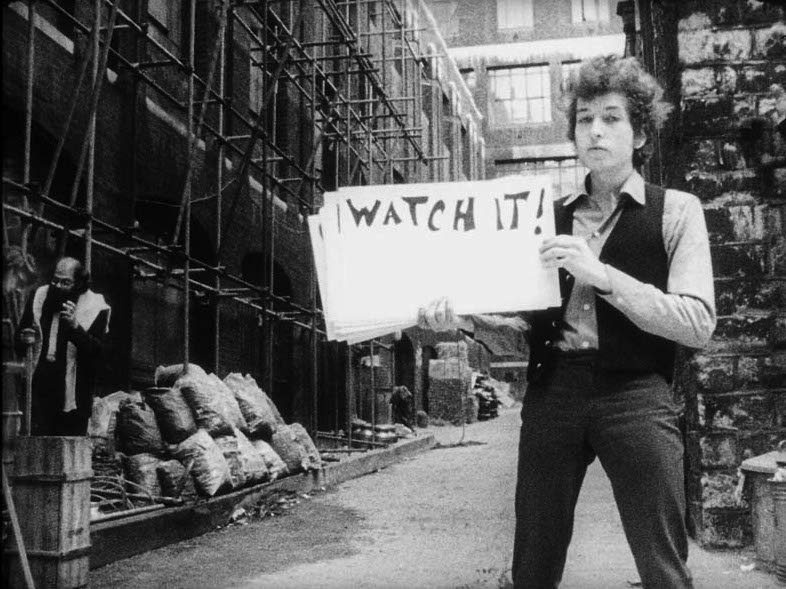
Marlow: How did Ginsberg get involved? Was he around?
Pennebaker: He was around. At that moment, he was just stopping by. Ginsberg was sort of a friend. I’d known him for a long time. He used to hide his marijuana in my girlfriend’s bureau! [Bob] Neuwirth, of course, was there because he was the road manager. I didn’t quite know what we were doing except that it was Dylan’s idea and I thought that it was a good one. We set up to do it in the alley there and they were just hanging around. I didn’t think about whether they were in or out of the picture. I was hardly aware of them! It has always amazed me that everybody takes it seriously as some kind of an aesthetic concept. It wasn’t, really. It just happened. When I saw that the film couldn’t begin with the backstage footage, I took this thing out and put it on the beginning of the film. It never came off because that was really what it needed. It was chance.
Marlow: With Dont Look Back and then Ziggy Stardust, you’re capturing artists in a period of transition. What is it about working with people at that stage in their careers that appeals to you?
Pennebaker: One of the ideas that we’d fallen on with [Robert] Drew, when we used to have discussions, was how do we know if this is a story? Where do we look for stories? Of course, we had all of these materials from all over the world. They were sending back these sheets on various news–situations and people—and we would look at them. Like Paul Krump getting the electric chair in Chicago…
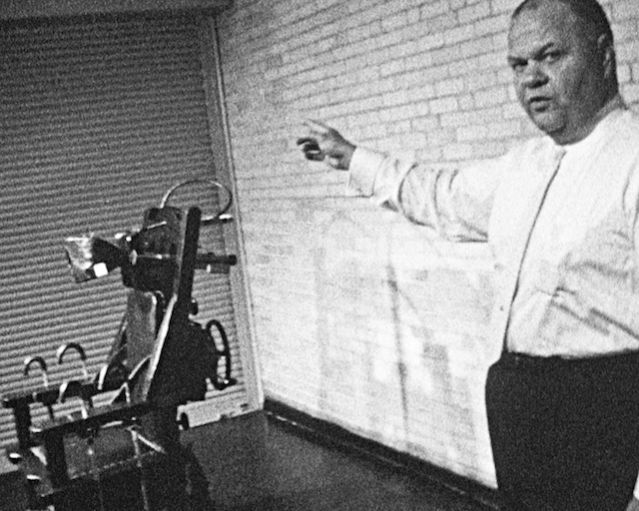
Marlow: Right, The Chair [directed by Robert Drew in 1963]…
Pennebaker: We decided to go and see if there was a movie there. Ricky [Leacock, cinematographer on the film] fell on the guy [Louis Nizer] who was his lawyer. That developed into a film but it started because we had these reporters as a resource. When I quit [Drew Associates], I didn’t have that resource anymore. I was at the mercy of people coming to me as a result of the movies that they’d seen or what they thought we could do and that’s been the case ever since. The movies pretty much come to us. We don’t really go out and search for them. When you’re planning a movie, you’re trying to decide whether or not the person is interesting to you. That’s important. But also you have to decide whether they’re at a moment in their life that is purposeful, that they’re going around some kind of corner and that they’re going to find out something that is going to enable them to make important decisions. Whatever it is, something important has to happen.
Marlow: It seems that your process on Monterey Pop was different.
Pennebaker: That was different…
Marlow: In this case, your focus isn’t a particular individual but a musical turning point of an era. Out of this one event, you had a wealth of material that you kept returning to: the Otis Redding short [Shake! Otis at Monterey], the feature-length Jimi Hendrix film [Jimi Plays Monterey, all eventually compiled together by Pennebaker and Criterion as The Complete Monterey Pop Festival with an additional two hours of outtakes]…
Pennebaker: But those come later…

Marlow: The music festivals at Monterey and Woodstock were such remarkable events on their own. Is their legend and legacy partially a result of being well documented?
Pennebaker: For Monterey, you have the emergence of two or three enormous talents that just defy description. You didn’t have to go through the sociology of interviewing them to find out what their motivations were. The performance alone was enough. We could have done backstage stuff—in fact, we did and then we threw it out because you only could have so many songs in a ninety-minute film and I wanted each song to be complete or at least have the audience think that they’d heard the whole song. Some of them had to be cut for various problematic reasons but, in general, I wanted it to be a series of full-length songs done by people who would do them in some unique fashion, building up to a dramatic ending with the Ravi Shankar performance. That was really the whole basis for the film. Since then, perhaps the form of the film was interesting for people. It’s easy to watch. It’s colorful and it moves fast but I think the fact is that most people go to it because of Hendrix or because of Janis [Joplin] or because of Otis. There’s not a lot of footage around of those people. It also isn’t a setting that tries to fulfill some sort of sociological exploration. I just thought that was not our role. I think that this is one of the problems with Woodstock. The reason that I didn’t do Woodstock was because there was so much money riding on it. The managers were so involved and hustling for position that a lot of the good bands and good music wasn’t even going to be there. I knew that Albert [Grossman] wasn’t going to let Dylan or The Band perform. It didn’t seem to me that, musically, it would be interesting.
Marlow: The structure of Monterey Pop is relatively the same as Down From the Mountain…
Pennebaker: Or Daybreak [Express], really. It’s like a remake of Daybreak.
Marlow: How did One P.M. come about? How did you end up making a film with [Jean-Luc] Godard?
Pennebaker: When I was in France at one point, I knew a number French filmmakers and I loved going out to dinner with them. They’d all speak French and I don’t speak French so I was just trying to soak it up in some way and understand what they were talking about. [Henri] Langlois was the major force among them all and, at one point, I ran across Godard and we talked about doing a film. He wanted to do a film with us. The idea was that he would set up some little town somewhere in

